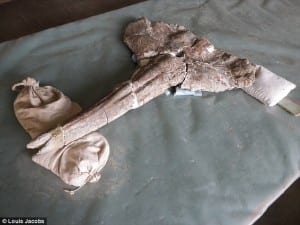The folks at SMU say a find like this is extremely rare, and for a five-year-old kid to have found it, may be more rare than the Dino itself.
The fossil bones of a 100 million-year-old dinosaur discovered at a shopping center construction site will be studied and identified by paleontologists at Southern Methodist University’s Shuler Museum of Paleontology.
The bones were discovered by a Dallas Zoo employee and his young son. The fossils have been transported to SMU’s Shuler research museum in the Roy M. Huffington Department of Earth Sciences.
The discovery of the bones, believed to be from the family of armored dinosaurs called nodasuaridae, was covered by local TV stations NBC Channel 5, CBS Channel 11 and Channel CW 33.
The story aired April 7, 2015.
EXCERPT:
By NewsFix
Channel CW 33
Dinosaurs come in all shapes and sizes. Well, it also turns out so do Dino-diggers.“Over the past few years, we’ve found a lot of really amazing things, but this is by far the most awesome thing we’ve found.”
Yeah, Dallas zoo keeper Tim Brys and his son Wiley hit the Jurassic jackpot while digging around a Mansfield shopping center development.
Wiley, who is just five-years-old, found something 100 million years in the making.
“He walked up here a head of me here and came back with a piece of bone. It was a pretty good size. I knew it was something interesting,” Brys said.
That interesting thing is what SMU paleontologists call a Nodosaur, a dinosaur probably as large as a horse, covered in armored plates.
Now this guy is headed to SMU to be examined.
“I don’t think it has hit either one of us just how amazing this is. I know it’s a once in a lifetime opportunity a lot of people never find something like this.” Brys said.
Follow SMUResearch.com on twitter at @smuresearch.
SMU is a nationally ranked private university in Dallas founded 100 years ago. Today, SMU enrolls nearly 11,000 students who benefit from the academic opportunities and international reach of seven degree-granting schools. For more information see www.smu.edu.
SMU has an uplink facility located on campus for live TV, radio, or online interviews. To speak with an SMU expert or book an SMU guest in the studio, call SMU News & Communications at 214-768-7650.




 17 million-year-old whale fossil provides 1st exact date for East Africa’s puzzling uplift
17 million-year-old whale fossil provides 1st exact date for East Africa’s puzzling uplift


